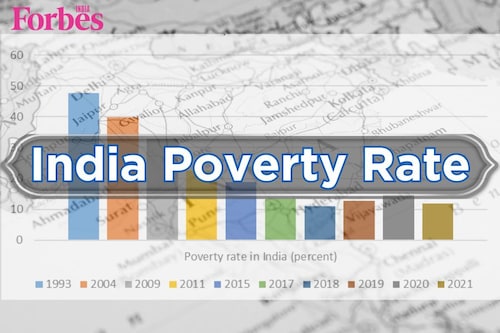Poverty rate in India [2024]: Trend over the years and causes
How has the poverty rate in India shifted over the years? What are the causes of poverty in India? Let's find it all out


Poverty in India is a complex and multifaceted issue influenced by a combination of historical, economic, social, and political factors. Several renowned economists and leaders have provided insights into the root causes of the high poverty rate in India.
Amartya Sen, the Nobel laureate economist, has highlighted the importance of addressing social inequalities and investing in education and healthcare to combat poverty in India and sustain economic development.
The 2023 Multidimensional Poverty Index Report finds over a third of all poor people in the world live in South Asia—which is around 389 million people. India contributes significantly to this number, accounting for almost 70 percent of the increase in extreme poverty.
The World Bank defines poverty using the International Poverty Line, which designates extreme poverty at $2.15 per person per day, while $3.65 falls under the lower-middle income category, and $6.85 is classified as upper-middle income.
Considering the poverty line set at $3.65, India"s contribution constitutes 40 percent of the slight upward adjustment in the global poverty rate, moving from 23.6 percent to 24.1 percent.
Based on the annual Household Consumption Expenditure Survey (HCES), conducted from August 2023 to July 2024, researchers at the State Bank of India released a report assessing the poverty rate in India. According to this SBI report, the poverty rate in India fell below 5 percent, nearly eradicating extreme poverty. It estimates that the current poverty rate is between 4 and 4.5 percent.
The findings also show that rural poverty dropped to 4.86 percent in FY24, a sharp decline from 7.2 percent in FY23 and 25.7 percent in FY12. Urban poverty also saw a reduction, falling to 4.09 percent in FY24, down from 4.6 percent in FY23 and 13.7 percent in FY12.
The SBI report adjusted the poverty line for inflation to determine the 2023-24 numbers at Rs1632 (rural) and Rs1944 (urban), respectively. These numbers were calculated based on the recommendations of the group of experts headed by Suresh Tendulkar, who had determined the poverty line in 2011-12.
"The sharp decline in the rural poverty ratio is on account of higher consumption growth in the lowest 0-5 per cent decile with significant Government support, and such support is important as we also find that change in food prices has a significant impact on not just food expenditures, but overall expenditure in general," the report states.
"It is possible that these numbers could undergo minor revisions once the 2021 census is completed and the new Rural-Urban population share is published. We believe Urban poverty could decline even further," the report said.
First Published: Mar 05, 2025, 18:12
Subscribe Now